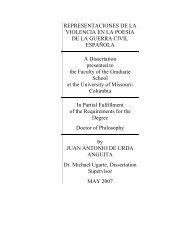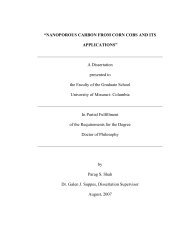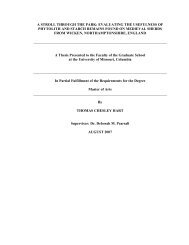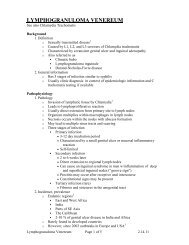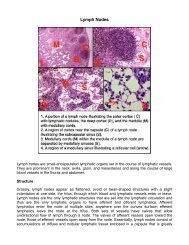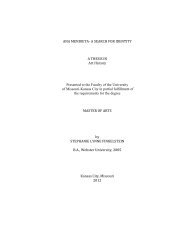SiDR: A SECURE INTER-DOMAIN ROUTING PROTOCOL FOR ...
SiDR: A SECURE INTER-DOMAIN ROUTING PROTOCOL FOR ...
SiDR: A SECURE INTER-DOMAIN ROUTING PROTOCOL FOR ...
You also want an ePaper? Increase the reach of your titles
YUMPU automatically turns print PDFs into web optimized ePapers that Google loves.
<strong>SiDR</strong>: A <strong>SECURE</strong> <strong>INTER</strong>-<strong>DOMAIN</strong> <strong>ROUTING</strong> <strong>PROTOCOL</strong> <strong>FOR</strong> FUTURE<br />
<strong>INTER</strong>NET<br />
A Thesis<br />
IN<br />
Computer Science<br />
Presented to the Faculty of the University<br />
of Missouri–Kansas City in partial fulfillment of<br />
the requirements for the degree<br />
MASTER OF SCIENCE<br />
by<br />
CHOCKALINGAM ESWARAMURTHY<br />
B. Tech., SRM University, Chennai, India, 2007<br />
Kansas City, Missouri<br />
2011
c○ 2011<br />
CHOCKALINGAM ESWARAMURTHY<br />
ALL RIGHTS RESERVED
SIDR: A <strong>SECURE</strong> <strong>INTER</strong>-<strong>DOMAIN</strong> <strong>ROUTING</strong> <strong>PROTOCOL</strong> <strong>FOR</strong> FUTURE<br />
<strong>INTER</strong>NET<br />
Chockalingam Eswaramurthy, Candidate for the Master of Science Degree<br />
University of Missouri–Kansas City, 2011<br />
ABSTRACT<br />
Inter-domain routing is a critical functionality that help connect autonomous sys-<br />
tems in the Internet. In recent years, there have been concerns in regard to its vulnera-<br />
bilities such as IP prefix hijacking and worm attacks. Many of the problems in the inter<br />
domain routing arises from the protocol complexity, lack of support for underlying poli-<br />
cies, vulnerabilities, convergence and route stability, scalability and isolation. A number<br />
of approaches have been proposed to address the known vulnerabilities.<br />
In this work, we propose an inter-domain routing protocol for future evolution<br />
of the Internet. Our approach, <strong>SiDR</strong> (Secure inter Domain Routing Protocol), addresses<br />
security and benefits from novel technique such as Attribute Based Cryptography (ABE)<br />
for achieving policy routing and information hiding. <strong>SiDR</strong> offers a new perspective and<br />
direction for discussions on inter domain routing. We focus on two aspects of inter domain<br />
routing that is of paramount importance; routing policies and security.<br />
iii
APPROVAL PAGE<br />
The faculty listed below, appointed by the Dean of the School of Computing and Engi-<br />
neering, have examined a thesis titled “<strong>SiDR</strong>: A Secure inter-Domain Routing Protocol<br />
for Future Internet,” presented by Chockalingam Eswaramurthy, candidate for the Master<br />
of Science degree, and hereby certify that in their opinion it is worthy of acceptance.<br />
Supervisory Committee<br />
Deep Medhi, Ph.D., Committee Chair<br />
Department of Computer Science & Electrical Engineering<br />
Lein Harn, Ph.D.<br />
Department of Computer Science & Electrical Engineering<br />
Yugi Lee, Ph.D.<br />
Department of Computer Science & Electrical Engineering<br />
iv
CONTENTS<br />
ABSTRACT . . . . . . . . . . . . . . . . . . . . . . . . . . . . . . . . . . . . . . iii<br />
ILLUSTRATIONS . . . . . . . . . . . . . . . . . . . . . . . . . . . . . . . . . . vi<br />
ACKNOWLEDGEMENTS . . . . . . . . . . . . . . . . . . . . . . . . . . . . . . vi<br />
Chapter<br />
1 INTRODUCTION . . . . . . . . . . . . . . . . . . . . . . . . . . . . . . . . . 1<br />
1.1 Overview of Inter Domain Routing and Security . . . . . . . . . . . . . . 2<br />
1.2 Problem Definition . . . . . . . . . . . . . . . . . . . . . . . . . . . . . 5<br />
1.3 Related Work . . . . . . . . . . . . . . . . . . . . . . . . . . . . . . . . 5<br />
1.4 Summary of Contributions . . . . . . . . . . . . . . . . . . . . . . . . . 9<br />
2 ATTRIBUTE BASED ENCRYPTION . . . . . . . . . . . . . . . . . . . . . . 10<br />
3 <strong>SiDR</strong> DESIGN . . . . . . . . . . . . . . . . . . . . . . . . . . . . . . . . . . . 13<br />
3.1 Policy Based Routing . . . . . . . . . . . . . . . . . . . . . . . . . . . . 15<br />
3.2 Security . . . . . . . . . . . . . . . . . . . . . . . . . . . . . . . . . . . 16<br />
4 <strong>SiDR</strong>: <strong>PROTOCOL</strong> ANALYSIS . . . . . . . . . . . . . . . . . . . . . . . . . 19<br />
4.1 Basic Route Propagation model using Attribute Based Encryption . . . . 20<br />
5 EVALUATION AND DISCUSSION . . . . . . . . . . . . . . . . . . . . . . . 22<br />
5.1 Logical Proof of Security . . . . . . . . . . . . . . . . . . . . . . . . . . 22<br />
5.2 Performance Evaluation . . . . . . . . . . . . . . . . . . . . . . . . . . . 23<br />
6 SUMMARY AND FUTURE WORK . . . . . . . . . . . . . . . . . . . . . . . 28<br />
6.1 Future Work - Boot Strapping mechanism . . . . . . . . . . . . . . . . . 28<br />
REFERENCE LIST . . . . . . . . . . . . . . . . . . . . . . . . . . . . . . . . . . 30<br />
VITA . . . . . . . . . . . . . . . . . . . . . . . . . . . . . . . . . . . . . . . . . 33<br />
v
ILLUSTRATIONS<br />
Figure Page<br />
1 High level architecture . . . . . . . . . . . . . . . . . . . . . . . . . . . 14<br />
2 Relationship between a DSD and DSS . . . . . . . . . . . . . . . . . . . 14<br />
3 Domain Formation . . . . . . . . . . . . . . . . . . . . . . . . . . . . . 15<br />
4 <strong>SiDR</strong> STATUS update format . . . . . . . . . . . . . . . . . . . . . . . . 21<br />
5 Route Information (Route Info) . . . . . . . . . . . . . . . . . . . . . . . 21<br />
6 DSS-List Information . . . . . . . . . . . . . . . . . . . . . . . . . . . . 21<br />
7 Encryption-decryption times for normal case-1 . . . . . . . . . . . . . . 26<br />
8 Encryption-decryption times for normal case-2 . . . . . . . . . . . . . . 26<br />
9 Encryption-Decryption Times for YouTube hijack attack . . . . . . . . . 26
ACKNOWLEDGEMENTS<br />
I would like to thank my academic advisor Dr. Deep Medhi for his guidance<br />
during my thesis research. This thesis work is my first research, and Dr. Medhi gives<br />
me a valuable mentoring from finding a research topic to writing papers. On the other<br />
hand, I would like to thank Dr. Lein Harn and Dr.Yugi Lee from Department of Computer<br />
Science and Electrical Engineering for their advice on my thesis work.<br />
I would like to thank my lab mates at the Computer Networking Research Labo-<br />
ratory (CoNReL) for their discussion and critiques.<br />
Furthermore, I would like acknowledge my entire family for their support and<br />
encouragement during the whole study of my master study.<br />
vii
CHAPTER 1<br />
INTRODUCTION<br />
Internet was designed for transmitting data from point A to point B as a best effort<br />
scheme. After almost 40 years, the core design of the Internet remains the same, but the<br />
demands of the Internet usage have been drastically changed. Future Internet design is<br />
a hot area of research today as researchers try to understand the dynamics and demands<br />
of todays’ Internet and predict the demands of future Internet thereby proposing novel<br />
framework and protocols that meet those demands. Today Internet relies heavily on the<br />
inter-domain routing to make communications happen on the Internet. The most popu-<br />
lar inter-domain routing protocol is the Border Gateway Protocol. Another protocol in<br />
the Asynchronous Transfer Mode (ATM) world is Private Network-to-Network Interface<br />
(PNNI). PNNI is a hierarchical state-of-art routing protocol and is known to use Quality-<br />
of-Service sensitive routing scheme by advertising topology state parameters and Call<br />
Admission Control [1] .<br />
Recent turn of events and studies have shown that the present inter domain rout-<br />
ing have a number of security vulnerabilities. Some of the commonly know threats are:<br />
(a) the nodes are vulnerable to active and passive wiretapping attacks, (b) a node may<br />
be compromised, and (c) Configuration information or routing database of a node may<br />
be modified or replaced via un-authorized access to a router or server or via a spoofed<br />
distribution channel. There has been several efforts to to negate these problems [13].<br />
1
1.1 Overview of Inter Domain Routing and Security<br />
At the heart of the Internet lies routing. Network Routing refers to the ability of an<br />
electronic communication network to send a unit of information from point A to point B<br />
by determining a path through the network, and by doing so efficiently and quickly [16].<br />
Routing essentially involves the following operations, (a) exchange of routing informa-<br />
tion between different systems (routers) that participate in the process and (b) finding<br />
the optimal path from point A to point B. Internet is made up of many entities known<br />
as autonomous systems. These autonomous systems define the administrative authority<br />
and routing policies of different organizations. Autonomous systems work by running<br />
inter domain and intra domain protocols that communicate reachability information be-<br />
tween themselves. The protocols that can are supported by a typical autonomous system<br />
are Border Gateway Protocol (BGP), Interior Gateway Protocol (IGP), Routing Informa-<br />
tion Protocol (RIP), Enhanced Interior Gateway Routing Protocol (EIGRP), Intermediate<br />
System-to-Intermediate System (IS-IS) etc. The standard exterior routing protocol that is<br />
used by the autonomous systems today is the BGP-4.<br />
Exterior Routing Protocols were created to control the expansion of the routing<br />
tables and also separate out routing domains into independent administrative domains<br />
that can have their own routing policies.<br />
Recent turn of events have shown that a number of security threats of the current<br />
inter domain routing has been exposed over the years thorough occasional accidents or<br />
misconfiguration and through extensive study and survey of the BGP protocol with respect<br />
to security. Murphy in RFC-4272 explained in detail the various vulnerabilities faced by<br />
2
BGP. The main reason for this weakness is since BGP as a protocol does not define any<br />
cryptographic mechanisms for authentication of the peer to peer communication. Since<br />
BGP is dependent on TCP transmission for its functioning, BGP is vulnerable to all those<br />
vulnerabilities faced in such communication such as IP spoofing, session stealing, TCP<br />
SYN attack, and so on. A third party can inject malicious AS numbers unintentionally or<br />
intentionally into a BGP stream thereby creating a havoc in the entire network. Some of<br />
the real world scenarios of such attacks would be the YouTube.com outage that occurred<br />
in February 2008 [19] and China Internet Hijacking in April 2010 [17]. A list of the<br />
known security threats of BGP as discussed in RFC-4272 can be classified as follows:<br />
• Confidentiality Violation: The routing information present in BGP is in plain text,<br />
hence it is vulnerable to eavesdropping and easy to plan attacks.<br />
• Replay: BGP as a protocol cannot distinguish between current BGP messages and<br />
replayed BGP message from previously recording activity.<br />
• Message Insertion/Deletion/Modification: BGP protocol does not have a mecha-<br />
nism to prevent a BGP message from being manipulated in any way by a genuine<br />
BGP speaker or a hacker.<br />
• Man-in-the-middle attack: As there is no authentication mechanism in BGP pro-<br />
tocol; it is easy to capture a packet, to modify it and to send it to the destination<br />
thereby diverting and extracting vital information from between the communicat-<br />
ing parties.<br />
3
• Denial-of-Service (DoS): Another widely seen attack is DoS attack. Because of<br />
today’s rapid growth in technologies and low-cost infrastructure, it is easy to design<br />
and develop such a attack at massive scale. Due to the in-availability of proper<br />
authentication mechanism, BGP is unable to stops such attacks.<br />
Further vulnerabilities of BGP were exposed by Hu et. al. in [10]. The classification of<br />
threats is as follows:<br />
• Falsification Attacks: Modification or false advertising a route in a BGP message<br />
is termed as falsification attack. Examples include falsifying the withdrawn route,<br />
falsifying a Network Layer Reachability Information (NLRI), falsifying path at-<br />
tributes, truncation, and so on.<br />
• Wormhole or tunnel: Another type of attack is a wormhole or tunnel. This specific<br />
mechanism creates a black hole in the network. Any information that goes into<br />
the black hole is essentially lost in there which can result in a major increase in the<br />
traffic of the network and can result in the phenomenon similar to the YouTube.com<br />
outage mentioned earlier.<br />
• Unauthorized AS path announcements: A hacker can intentionally announce pre-<br />
fixes that are not supposed to be announced as per policies of the ISP. This increases<br />
the overall traffic in the network, causing congestion, and performance degradation.<br />
4
1.2 Problem Definition<br />
The goal of our work is to propose a novel protocol <strong>SiDR</strong> for securing the inter<br />
domain routing and communication in the future Internet. Briefly, we use Attribute Based<br />
Cryptography for securing the inter domain routing updates.<br />
Inter domain routing presents a challenging task of policy, security and algorith-<br />
mic properties to be satisfied. It has become highly aware that routing policies are a matter<br />
of serious concern in the inter domain routing design space. The IRTF and SIDR working<br />
groups have put together a set of requirements to be considered while designing a future<br />
inter domain routing protocol [20]<br />
From this non-exhaustive list of specifications we chose two design constrains for<br />
designing <strong>SiDR</strong>, namely: (a) Policy routing: A future inter domain routing must support<br />
policy routing by design. By this it is possible to avoid highly mysterious and onerous<br />
ways of configuring policies and its decision processes. (b) Security : Information hiding<br />
is a crucial design requirement for any protocol today. The inter domain routing informa-<br />
tion exchanged between systems today make the Internet vulnerable to localized security<br />
or misconfiguration.<br />
1.3 Related Work<br />
In this section, we will briefly discuss the current literatures.<br />
Today the widely used inter domain routing protocol is Border Gateway Protocol<br />
(BGP). Recent turn of events have shown BGP being vulnerable to various types of attacks<br />
5
and over the years, a number of approaches have been proposed to address the security is-<br />
sues associated with the current inter-domain routing protocol namely, BGP. Events such<br />
as the YouTube.com hijacking [19] and Internet hijacking [17] have a got topic of discus-<br />
sion recently. Heffernan proposed to protect BGP sessions via TCP MD5 signature option<br />
RFC-2385. Ferguson and Senie RFC-2827 proposed to use network ingress filtering to<br />
negate denial of service attacks which employ IP source address spoofing. Geofferey et<br />
al proposed the Inter domain Route Validation (IRV) service to work around BGP by in-<br />
troducing a receiver based protocol that works in parallel with BGP to give feedback to<br />
the sender about a UPDATE message [9]. IPSec has also been proposed to secure BGP<br />
sessions. While IPSec is not specific to BGP alone, it is a protocol stack to secure com-<br />
munication between two entities. A list of approaches has been summarized in the BGP<br />
survey paper [7].<br />
Secure-BGP was the first proposed architecture to solve the security issues with<br />
BGP [14]. S-BGP employs three security mechanisms: (a) A public key infrastructure<br />
that parallels the IP address and AS number assignment to enable authentication of own-<br />
ership of IP address blocks, autonomous system numbers, AS identity and BGP router’s<br />
identity, (b) S-BGP added a new attribute path called the BGP transitive path attribute to<br />
carry the digital signatures; this is used for attestation purposes and (c) IPSec was pro-<br />
posed to be used to provide data communication integrity. The goal of S-BGP was to<br />
achieve the correct operation of BGP as defined in the S-BGP proposal.<br />
Secure Origin BGP (soBGP) is another mechanism for securing the border gate-<br />
way protocol [22]. soBGP followed schemes such as S-BGP, Internet Route Verification,<br />
6
and DNS- based Network Layer Reachability Information (NLRI) origin AS verifica-<br />
tion in BGP [2]. The main goals of soBGP were quite similar to those of the S-BGP.<br />
soBGP proposed to separate the authentication mechanism from the core BGP processing.<br />
soBGP assumes that the security between two BGP speakers are addressed through mech-<br />
anisms like BGP MD5, GTSH. soBGP was more concerned with securing the informa-<br />
tion within BGP using certificate mechanisms. It proposed protocol extensions [SOBGP-<br />
BGPTRANSPORT], [SOBGP-CERTIFICATE], [SOBGP-RADIUS] and certificates En-<br />
tityCert - that ties an AS number to a public key, AuthCert - that ties an AS to a block of<br />
addresses that a AS may advertise. soBGP separated out the adjacency between devices<br />
running the routing protocol and the information carried within the routing protocol and<br />
hence, this requires additional cryptographic devices to perform the authentication pro-<br />
cess. From the certificates and BGP UPDATE messages each AS builds a AS connectivity<br />
graph using that future UPDATES can be validated.<br />
Secure Path Vector protocol [10] is an innovative increment of the original S-<br />
BGP. SPV is a new protocol to secure BGP UPDATE message. The broader goal of<br />
the SPV protocol was to achieve incremental benefits with minimal changes to existing<br />
code. However, there are some limitations for most practical security mechanism to detect<br />
all BGP security failures, for example, handling of Byzantine failures are difficult. Since<br />
each AS can potentially change the content of update message or change the policy simply<br />
because it does not want to forward a particular AS number as per their local policy. In<br />
such cases, it is difficult to identify if a router is functioning properly. SPV proposed<br />
to use symmetric cryptography, replacing the asymmetric cryptography in S-BGP. It was<br />
7
then shown that the performance of the algorithm speeds up by 22 times when compared<br />
to S-BGP.<br />
An important goal of SPV was to achieve ASPATH integrity through purely sym-<br />
metric functions. A new cryptographic construction was introduced known as ASPATH<br />
Protector to achieve ASPATH integrity. The concept of epochs of fixed length and pe-<br />
riodic updates to prevent replay attacks was also introduced. SPV proposes to use four<br />
different types of private and public keys namely (a) single ASN public/private keys -<br />
used to authenticate signature of one AS in ASPATH, (b) Epoch public key, (c) Multi<br />
epoch public key, prefix public/private key - standard RSA algorithm used and the prefix<br />
private keys are to be distributed by the ICANN.<br />
<strong>SiDR</strong> loosely builds upon another work that explores a new link state protocol<br />
for securing the inter-domain routing [12]. This architecture explains the various attacks<br />
possible on a BGP protocol and presents a design for building a secure network. The<br />
major difference between <strong>SiDR</strong> and this architecture is that we consider the secure pro-<br />
tocol from a policy aspect point of view. Being able to embed policies in a inter-domain<br />
protocol is a very important feature as it solves many problem from configuring a network<br />
to specifying access permissions. Another work that builds on the previously mentioned<br />
paper is [15]. In this work the authors present a detailed study of different types of attacks<br />
that are possible on a network and present a infrastructure for negating them. This work<br />
however does not capture the policy aspect of the network. <strong>SiDR</strong> not only encrypts the<br />
updates against various forms of attacks, it also gives the flexibility to specify network<br />
specific policies and also support dynamic domains.<br />
8
Our contributions are the following:<br />
1.4 Summary of Contributions<br />
• We propose a new inter domain routing protocol for future Internet by leveraging<br />
on novel techniques like Attribute based encryption.<br />
• We logically prove how the proposed architecture is robust against proven attacks.<br />
• We present performance and security evaluation of the proposed protocol.<br />
9
CHAPTER 2<br />
ATTRIBUTE BASED ENCRYPTION<br />
Attribute Based Encryption (ABE) is a novel idea of encrypting the information<br />
based on the attributes of the participating entities. This allows the flexibility of a dy-<br />
namic environment and also has the added benefit of shorter key sizes compared to most<br />
the cryptographic algorithms available today. A number of approaches for ABE such a<br />
Cipher-Text policy based ABE, Multi-Authority ABE, Bounded CipherText ABE, Key-<br />
Policy based ABE have been previously proposed.<br />
A central authority will create secret keys for the node based on its attributes/policies.<br />
Nodes in the system have attributes. They receive a key from an authority for its set of<br />
attributes. Ciphertext contains a policy (a boolean predicate over the attribute space). If<br />
a nodes’ attribute set satisfies the policy, then it can use its key bundle to decrypt the<br />
ciphertext. For instance, the service provider may specify the following access structure<br />
for sending out route update based on a policy that the receiving entity should be a DSS<br />
(Dynamic Service System), and it should have a med value of 20 and action pref 1: (DSS<br />
AND med = 20 OR action pref = 1 ), by this, the service provider will be able to do policy<br />
routing. An access structure can be represented as a expression tree with the AND, OR<br />
operator at every node and the labels being the properties or attributes.<br />
ABE benefits from its fundamental mathematical construction called Bilinear maps<br />
like other encryption methodologies such as Elliptic Curve Cryptography (ECC), Identity<br />
10
Based Encryption (IBE) and Pairing Based Cryptography (PBC). It is important to note<br />
that the security and strength of ABE is based on the Decisional Diffie-Hellman prob-<br />
lem [5]. A detailed analysis and proof for this can be found here [23]. A note on the<br />
performance of the ABE can be found here [4].<br />
Attribute based encryption follows four fundamental algorithms; they are Setup,<br />
Encrypt, Key Generation, and Decrypt. We use the CP-ABE construction and algorithm<br />
as described in [4].<br />
• Setup phase: During this phase, the master key is generated. The setup algorithm<br />
chooses a bilinear group G 0 of prime order p with a generator g. It will choose two<br />
random exponents α, β, and Zp. The public key generated is:<br />
PK = G 0 , g, h = g β and the master key is (β, g α ) The setup function is a two<br />
step process, it generates a public key and a master key which can be used with<br />
the encryption, decryption module and it generates private keys for each of the sub<br />
nodes.<br />
• Encryption phase: The encryption algorithm takes the public parameters, message<br />
and access structure to produce the ciphertext CT. The ciphertext will also contain<br />
the access structure. CT is calculated using the formula:<br />
CT = (τ. � C = Me(g, g) α.s , C = h s , ∀ɛY : Cy = g qy(0) , C ′ y = H(att(y) qy(0) ).<br />
The input to this encryption function will be the public key generated in the setup<br />
step, the policy attributes and the message to be encrypted.<br />
• c. Key generation phase: The key generation algorithm takes the master key and<br />
11
the attribute sets to generate the private key SK. The formulation for the KeyGen<br />
algorithm is:<br />
SK = (D = g (α+γ)/β , ∀ɛS : Dj = g r .H(j) rj , D ′ j = g rj ).<br />
• d. Decryption phase: The decryption algorithm takes the ciphertext and only if the<br />
recipient’s attributes are satisfied by the access structure. The formulation used for<br />
decryption is:<br />
M = � C/(ehs ,g (α,γ)/β ) (g,g) /e γ,s<br />
) The DSS will use its private key obtained from the<br />
registration process from its parent DSD. The private key is basically a expression<br />
tree with the nodes being either logical AND or OR gates and the labels being each<br />
of the attribute of the DSS.<br />
12
CHAPTER 3<br />
SIDR DESIGN<br />
Inter domain routing presents a challenging task of policy, security and algorith-<br />
mic properties to be satisfied. It has become highly aware that routing policies are a matter<br />
of serious concern in the inter domain routing design space. The IRTF and SIDR working<br />
groups have put together a set of requirements to be considered while designing a future<br />
inter domain routing protocol [20] . From this non exhaustive list of specifications we<br />
chose two design constrains for designing <strong>SiDR</strong>. (a) Policy routing: A future inter do-<br />
main routing must support policy routing by design. By this it is possible to avoid highly<br />
mysterious and onerous ways of configuring policies and its decision processes. Many of<br />
today’s issues arise due to simple misconfiguration. (b) Security : Information hiding is a<br />
crucial design requirement for any protocol today. The inter domain routing information<br />
exchanged between systems today make the Internet vulnerable to localized security or<br />
misconfiguration. It is to be noted that a simple mis configuration can bring down the<br />
entire network.<br />
We start this section by describing the structure of <strong>SiDR</strong>, support for policy routing<br />
and security features of <strong>SiDR</strong>.<br />
The structure of <strong>SiDR</strong> is hierarchical by design. We introduce the concept of Dy-<br />
namic Service Domains (DSD), Dynamic Service Systems (DSS) and super-Domains.<br />
13
Figure 1: High level architecture<br />
Figure 2: Relationship between a DSD and DSS<br />
DSD’s are networks owned and operated by single entity or institution. A DSS is a sub-<br />
system to a particular DSD. DSS can either be a virtualized entity or a physical entity.<br />
The concept of virtualized entities is explained in other work [11] . super-Domains are a<br />
level above the DSD’s and are primarily concerned with setting up of global parameters or<br />
attributes for a DSD. We base our design leveraging on the existing hierarchical structure<br />
of ICANN.<br />
Fig. 1 shows the high level routing structure of <strong>SiDR</strong>. Fig. 2 shows the relationship<br />
14
Figure 3: Domain Formation<br />
between a DSD and a DSS. We illustrate an example of domain formation in Fig. 3<br />
3.1 Policy Based Routing<br />
Inter domain routing protocol has become inherently complex due to the incre-<br />
mental modification of the protocol by accommodating policies and decision processes.<br />
This has led to several problems, including unforeseen security vulnerabilities, widespread<br />
misconfiguration and conflicts betweens policies of different service providers. Today’s<br />
Internet relies on service level agreements (SLA’s) to be able to enforce policies for legal<br />
and financial reasons. SLA is a contractual agreement between a service provider and a<br />
service requester. However, it is critical to be able to enforce policy from a design per-<br />
spective as well. In <strong>SiDR</strong>, we provide this ability for a DSD to configure the policy based<br />
on the attributes of a individual DSS. Attribute based encryption (ABE) becomes a natural<br />
suitor for achieving this requirement.<br />
15
3.2 Security<br />
<strong>SiDR</strong> leverages on Attribute Based Encryption for achieving information hiding<br />
requirement of inter domain routing protocol. Attribute Based Encryption (ABE) is a<br />
novel idea of encrypting the information based on the attributes of the participating enti-<br />
ties. This allows the flexibility of a dynamic environment. A number of approaches for<br />
ABE such a Cipher-Text policy based ABE, Multi-Authority ABE, Bounded CipherText<br />
ABE, Key-Policy based ABE have been previously proposed.<br />
ABE benefits from its fundamental mathematical construction called Bilinear maps<br />
like other encryption methodologies such as Elliptic Curve Cryptography (ECC), Identity<br />
Based Encryption (IBE) and Pairing Based Cryptography (PBC). The cryptographic tech-<br />
nologies that are constructed from Bilinear Maps also have the advantage of smaller key<br />
sizes as when compared to other standard cryptographic algorithms and this vastly helps<br />
in improving the processing times. It is important to note that the security of ABE is based<br />
on the Decisional Diffie-Hellman problem [5] which makes it robust against various at-<br />
tacks. A detailed analysis and proof for this can be found here [23]. In our approach, we<br />
would like to use ABE mainly for securing the content, enabling levels of serviceability<br />
(Security) and to support the dynamic serviceability.<br />
Attribute based encryption follows four fundamental algorithms; they are Setup,<br />
Encrypt, Key Generation, and Decrypt. We use the CP-ABE construction and algorithm<br />
as described in [4].<br />
16
• Setup phase: Setup()<br />
The setup algorithm is run at the DSD, it takes no input other than the implicit<br />
security parameter. It outputs the public parameters PK and a master key MK.<br />
• Key generation phase: Key Generation (MK, SDSS)<br />
The key generation algorithm is also run at the DSD, it takes as input the master<br />
key MK and a set of attributes SDSS for a particular DSS that describe the key. It<br />
outputs a private key SKDSS for a particular DSS. This step is repeated for each<br />
of the DSS that registers with the DSD. Thus generating key pairs for DSS and<br />
distributing it to them. The private keys are distributed to individual DSS’s using<br />
Identity Based Encryption [6]. Public parameters for a particular DSS can be its<br />
attributes, for example DSSID, level of service etc.<br />
• Encryption phase: Encrypt (PK, STATUS, Policy)<br />
The encryption algorithm takes as input the public parameters PK, the <strong>SiDR</strong> STA-<br />
TUS, and an access structure Policy over the universe of attributes. The algorithm<br />
will encrypt STATUS and produce a ciphertext CTDSS such that only that DSD that<br />
possesses a set of attributes that satisfies the access structure Policy will be able to<br />
decrypt the message. We will assume that the cipher text implicitly contains Policy<br />
.<br />
• Decryption phase: Decrypt (PK, CTDSS, SKDSS)<br />
The decryption algorithm takes as input the public parameters PK, a ciphertext<br />
CTDSS, which contains an access policy Policy , and a private key SKDSS, which<br />
17
is a private key for a set SDSS of attributes. If the set SDSS of attributes satisfies the<br />
access structure Policy then the algorithm will decrypt the ciphertext and return a<br />
message STATUS.<br />
The DSS’s exchange the STATUS message using the ABE encryption as described<br />
in the encryption phase.<br />
18
CHAPTER 4<br />
SIDR: <strong>PROTOCOL</strong> ANALYSIS<br />
This section illustrates the proposed <strong>SiDR</strong> protocol information and packet format.<br />
Fig. 4, and Fig. 5 represents the different messages that gets exchanged. In Fig. 6 we show<br />
how the domains are formed based on policies and logical grouping by ABE. Let’s assume<br />
level-1 has highest security, level-2 has medium security and level-3 has low security. The<br />
levels of security can either be chosen by a parent DSD or a super-Domain, or by using a<br />
distributed polling approach as that of the PGP mechanism. The level of security will be<br />
an attribute for each of the DSS and is obtained at the time of registration. It is important<br />
to note that the DSS belonging to different levels of security can be of the same network<br />
also as depicted in the example Fig. 6. If we want to change a policy and do a re-ordering<br />
of the logical group, we just need to change the ”level” that we input to the ABE algorithm<br />
without any extra work or configuration.<br />
The service providers can provide variable levels of security based on the levels.<br />
An example would be to have the government information classified as level-1 and when<br />
using ABE, level-1 would be a attribute to the algorithm. This also allows the classified<br />
information to remain as a separate domain at the high level even though they will be<br />
physically connected to other DSD’s.<br />
<strong>SiDR</strong> STATUS message is used to exchange information between different DSD’s.<br />
The DSD STATUS message contains a aggregated route information of a list of DSS that<br />
19
are accessible through that particular DSD. This message is exchanged between DSD’s to<br />
obtain the connectivity information to various DSS’s. Each DSD has a unique ID called<br />
the DSDID that is obtained from the super-Domain. The message format for this message<br />
is depicted in Fig. 4. Each DSS will have the a unique ID assigned by the DSD, this<br />
information will be communicated between individual DSS and DSD. Different DSD’s<br />
are identified based on the level of service. The STATUS message is encrypted using ABE<br />
as per the policy specified by the transmitting entity. In order to validate the authenticity<br />
of the sender <strong>SiDR</strong> uses the digital signature mechanism in the protocol.<br />
4.1 Basic Route Propagation model using Attribute Based Encryption<br />
Based on the hierarchical routing structure of <strong>SiDR</strong> discussed in the previous sec-<br />
tion, we will use the simple path vector protocol along with ABE to achieve the dual goal<br />
of policy routing and information hiding.<br />
The ABE-set up algorithm and ABE- key generation algorithm are run at enti-<br />
ties higher in the hierarchy. Hence, the super-Domain generates the security keys and<br />
attributes for individual DSD’s. The DSD in turn generate the security keys and attributes<br />
for individual DSS’s belonging to them.<br />
Each routing information exchange is encrypted using the encryption algorithm<br />
mentioned in the previous section. Similarly, every message received is decrypted using<br />
the decryption algorithm mentioned in the previous section.<br />
In order to achieve policy routing, let us consider an example, suppose we want to<br />
20
Figure 4: <strong>SiDR</strong> STATUS update format<br />
Figure 5: Route Information (Route Info)<br />
Figure 6: DSS-List Information<br />
configure a policy for shortest path in today’s router we specify say the local pref param-<br />
eter equal to one and the multi-exit-discriminator to twenty. In <strong>SiDR</strong>, we can specify this<br />
policy as (’pref=1’) and(’med=20’) as the policy string during our encryption phase.<br />
Now suppose, we have another policy that only the DSS’s local to a specific DSD<br />
should be able to decode the route information exchange, then we can pass the policy<br />
string (DSS and ’domain=local’) as one of the inputs for the encryption algorithm. So<br />
only those entities that match the attributes will be able to decode the route information.<br />
By doing this we achieve information hiding by using the hierarchical structure of <strong>SiDR</strong><br />
to avoid vulnerabilities like localized security or configuration problems. ABE policies<br />
can be written as a set of policies and is easy to configure and implement by the provider.<br />
21
are:<br />
CHAPTER 5<br />
EVALUATION AND DISCUSSION<br />
We explain below the security evaluation of <strong>SiDR</strong>.<br />
5.1 Logical Proof of Security<br />
<strong>SiDR</strong> architecture is logically proved to be secure based on three assertions. They<br />
1. Unique Identity Registration To join a DSD a particular entity has to obtain a pair<br />
of attributes and unique key pairs to take part in the network. Mechanisms such as<br />
those listed in the bootstrapping section can be modified and used here.<br />
2. A distributed key generation/distribution approach Attributes and Key pairs ob-<br />
tained from a DSD will not be valid under another DSD unless transferred properly.<br />
3. Breaking a Bilinear construction is Decisional Diffie-Hellman problem The secu-<br />
rity and strength of <strong>SiDR</strong> is based on Decisional Diffie-Hellman Assumption and<br />
breaking its construction is considered a Decisional Diffie-Hellman problem.<br />
Property 1 assures that every DSS is uniquely identifiable. Consider a Man-in-the<br />
middle scenario, any third party in-order to participate in the network will have to go<br />
through the registration process to obtain the attributes and key pairs. Without these it<br />
cannot participate inside the DSD. We assume there is also a off line verification mecha-<br />
nism to register the identity and hence is traceable. Without the attributes and key pairs<br />
22
it is difficult for a third party to act as another DSS. Even if it does forge the attributes,<br />
without the access structure and key pairs its not possible to decrypt the message. Hence,<br />
based on our assertions, we show that <strong>SiDR</strong> is resistant to third party attacks. Unless<br />
a entity is a ”registered” part of the network, there is little possibility of performing at-<br />
tacks such as modifying a STATUS message of <strong>SiDR</strong> or inserting false routes into the<br />
STATUS message, thus making it secure by design. Property 2 assures that a third party<br />
cannot obtain or forge a key pair without having the appropriate attributes to participate<br />
in the process. Property 3 assures that cryptanalysis techniques will lead to the Decisional<br />
Diffie-Hellman problem which is mathematically considered not solvable.<br />
There is however a possibility of insider attack, which require further study to<br />
strengthen the protocol. Lets’ take the case of a compromised DSS, if a hacker some-<br />
how gains access into a DSS, he will gain access to the attribute set and key pairs. This<br />
will enable him to perform attacks like sending out invalid routes and creating a black-<br />
hole. However it should be noted that a insider attack is ”traceable” because of its unique<br />
identity which makes it easier for administrators to track the source of attack and fix it.<br />
5.2 Performance Evaluation<br />
In this section, we discuss the performance of <strong>SiDR</strong> and contrast with SPV. We<br />
chose to compare and contrast with SPV because SPV is considered to be the most effi-<br />
cient secure inter domain protocol available and a comparison would give us a fair idea<br />
of how well <strong>SiDR</strong> performs.<br />
We evaluate the security and efficiency of <strong>SiDR</strong> and compare it with the Secure<br />
23
Path Vector Protocol [10] . We first give the logical proof of security of <strong>SiDR</strong> and then<br />
analyze the performance of the encryption methodology used.<br />
For performance evaluation, we have collected data from the Oregon Route View<br />
Server for the day Sunday, 24 February 2008. This was the period when YouTube.com<br />
was hijacked on a global scale and went down for several hours. We chose this data to<br />
best reflect the heavy usage pattern of the routing protocol. In order to understand the<br />
behavior of the protocol under normal circumstances, we chose two additional datasets 8<br />
months apart before and after the YouTube.com hijack incident.<br />
In order to understand the diversity of the YouTube.com hijack data set, we present<br />
some of its facts obtained using a simple script below:<br />
1. There were about 260671 different prefixes that appeared in the data.<br />
2. About 27762 different AS numbers appeared in the data.<br />
3. At this time there were about 65184 different AS-AS connections.<br />
SPV is built upon Rijndael block cipher with a 128-bit key and a 128-bit block<br />
size, so we chose to use Advanced Encryption Standard 128 bit which is also based on<br />
Rijndael block cipher for a comparison. The ABE toolkit was obtained from [3] . The<br />
security of ABE algorithm is based on Decisional Diffie-Hellman assumption and break-<br />
ing it is considered mathematically unsolvable.For evaluation purposes, we consider two<br />
cases first the extreme case which is the YouTube.com hijack scenario and the normal<br />
case which is the dataset collected on a time without any specific outage or attack. Fig. 7,<br />
Fig. 8 shows the times taken for encryption and decryption of the extreme case inter<br />
24
domain routing data dump from the Oregon route view server for SPV and <strong>SiDR</strong>. The<br />
BGP-4 spec defined in RFC 4632, the smallest BGP data that can be in any network is<br />
the BGP header alone without any data is 19 bytes in size. The biggest BGP packet to<br />
be supported by any router in the network is about 256kb in size. The three datasets, the<br />
Full Data, Half Data and Quarter Data are provided solely for analysis purposes to test the<br />
extremeness of each algorithms. But in a real scenario, a specific node will not process<br />
data of sizes bigger than 256KB at a given time.<br />
As mentioned before, we obtained three different datasets from Oregon route<br />
views server as mentioned in the above section. Each operation (encryption / decryp-<br />
tion) for each of the data set was run thrice and the average of the three values were taken<br />
to plot the graphs given below.<br />
We see in Fig. 7, which is a dataset collected 8 months before the YouTube.com<br />
hijack incident and Fig. 8, which is collected 8 months after that YouTube.com hijack<br />
incident, that the encryption speeds of SPV is at least twice as faster when compared to<br />
<strong>SiDR</strong>.<br />
In case of encryption, the YouTube.com hijack scenario of Full Data dataset for<br />
<strong>SiDR</strong> was slower than SPV by approximately 20%. This is depicted in Fig. 9. For normal<br />
case 1 and normal case 2 datasets the encryption times of Full Data for <strong>SiDR</strong> was slower<br />
than SPV by approximately 30%. This is depicted in Fig. 7 and Fig. 8.<br />
In case of decryption, the YouTube.com hijack scenario of Full Data for <strong>SiDR</strong> was<br />
as fast as SPV by less than 2%. This is depicted in Fig. 9. For normal case 1 and normal<br />
case 2, the decryption time of <strong>SiDR</strong> was close to 2% the time taken by SPV.<br />
25
Figure 7: Encryption-decryption times for normal case-1<br />
Figure 8: Encryption-decryption times for normal case-2<br />
Figure 9: Encryption-Decryption Times for YouTube hijack attack<br />
26
<strong>SiDR</strong> key distribution is in built and the communication is based on the attributes<br />
itself. Secondly, <strong>SiDR</strong> follows a hierarchical structure for information hiding and security<br />
and hence do not explicitly require digital signature. As explained in the proof section,<br />
any entity without a registered set of attributes cannot take part in the communication.<br />
Two major drawbacks of SPV are :<br />
a. Key distribution mechanism is not identified.<br />
b. SPV will require digital certificates for authentication, and hence an processing<br />
overhead and key revocation is a issue.<br />
27
CHAPTER 6<br />
SUMMARY AND FUTURE WORK<br />
In this thesis, we have proposed a novel secure inter domain routing protocol<br />
for future Internet in our attempt to solve the vulnerabilities of inter domain routing by<br />
leveraging on a novel encryption technique called Attribute Based Encryption. We have<br />
proposed the concepts of Dynamic Domain Systems and Dynamic Service Systems as<br />
part of the future Internet architecture.<br />
To summarize our work in short words:<br />
• Proposed a new inter domain routing protocol for future Internet by leveraging on<br />
novel techniques like Attribute based encryption.<br />
• Logically prove how the proposed architecture is robust against proven attacks.<br />
• Performance and security evaluation of the proposed protocol.<br />
6.1 Future Work - Boot Strapping mechanism<br />
A number of protocols and techniques are available today for enabling bootstrap-<br />
ping. <strong>SiDR</strong> can benefit from one of these mechanisms tailoring specifically for our pur-<br />
pose. Bootstrapping of <strong>SiDR</strong> will be the next step in this work. The Session Initiation<br />
Protocol (SIP) defined in RFC3261 is a IETF defined signaling protocol for voice and<br />
media application sessions. SIP is widely used in the area of Voice-Over-IP applications.<br />
28
The registration mechanism in SIP can be used as a reference for designing the bootstrap-<br />
ping mechanism of <strong>SiDR</strong>. SIP has a HTTP like text oriented message format and headers<br />
with fields like FROM, TO etc. In SIP the user registers with say his email address and<br />
obtains a phone number which can be used to the user through VoIP. The DSS-DSD reg-<br />
istration process can also benefit from the Dynamic Host Configuration Protocol where a<br />
node requesting a identity (IP in this case) can broadcast its request to a DSD to obtain<br />
the attributes and key pairs. However, in addition to this there should also be a off line<br />
verification process to ensure the credibility of the entity.<br />
Another approach that can be explored for registration as well as transferring the<br />
identity of a DSS from a DSD is the home location register (HLR) and visitor location<br />
register (VLR) from the network switching subsystem of a GSM network. When ever a<br />
user registered to particular DSD ”visits” another DSD then the DSS can go through a<br />
similar authentication center (AUC) based process to transfer the identity from the parent<br />
DSD to the current DSD.<br />
The Host Identity Protocol (HIP) specified in RFC 4423 is also another protocol<br />
that can be considered to perform the bootstrapping mechanism for <strong>SiDR</strong>. HIP is a new<br />
protocol layer between inter networking and transport layers of the OSI stack. HIP is also<br />
a name space for giving a node with a particular identity. HIP name space can also be<br />
used as a reference for designing the ”identity” of a DSS, DSD etc.<br />
29
REFERENCE LIST<br />
[1] ATM Forum Technical Committee. Private Network-Network Interface<br />
Specification Version 1.1. Available from. http://www.cisco.com/<br />
univercd/cc/td/doc/product/wanbu/bpx8600/pnni_ses/<br />
rel11/pnnipg/pintro.htm(2000); accessed 18 August 2011.<br />
[2] Bates, T., Bush, R., Li, T., and Rekhter, Y. DNS-based NLRI origin AS<br />
verification in BGP. Available from. http://tools.ietf.org/html/<br />
draft-bates-bgp4-nlri-orig-verif-00 (1998); accessed 18 August<br />
2011.<br />
[3] Bethencourt, J., Sahai, A., and Waters, B. Ciphertext-Policy Attribute-Based<br />
Cryptography Toolkit. Available from. http://acsc.cs.utexas.edu/<br />
cpabe (2006); accessed 18 August 2011.<br />
[4] Bethencourt, J., Sahai, A., and Waters, B. Ciphertext-Policy Attribute-Based En-<br />
cryption. In Proceedings of the 2007 IEEE Symposium on Security and Privacy<br />
(Washington, DC, USA, 2007), SP ’07, IEEE Computer Society, pp. 321–334.<br />
[5] Boneh, D. The Decision Diffie-Hellman Problem. In Proceedings of the Third<br />
International Symposium on Algorithmic Number Theory (London, UK, 1998),<br />
Springer-Verlag, pp. 48–63.<br />
30
[6] Boneh, D., and Franklin, M. K. Identity-Based Encryption from the Weil Pairing. In<br />
Proceedings of the 21st Annual International Cryptology Conference on Advances<br />
in Cryptology (London, UK, 2001), CRYPTO ’01, Springer-Verlag, pp. 213–229.<br />
[7] Butler, K., Farley, T., McDaniel, P., and Rexford, J. A Survey of BGP Security<br />
Issues and Solutions. Proceedings of the IEEE 98, 1 (Jan. 2010), 100 –122.<br />
[8] Caesar, M., and Rexford, J. BGP routing policies in ISP networks. Network, IEEE<br />
19, 6 (Dec. 2005), 5 – 11.<br />
[9] Goodell, G., Aiello, W., Griffin, T., Ioannidis, J., McDaniel, P., and Rubin, A. Work-<br />
ing Around BGP: An Incremental Approach to Improving Security and Accuracy of<br />
Interdomain Routing. In In Proc. NDSS (2003).<br />
[10] Hu, Y. C., Perrig, A., and Sirbu, M. SPV: Secure Path Vector Routing for Secur-<br />
ing BGP. In Proceedings of the 2004 Conference on Applications, Technologies,<br />
Architectures, and Protocols for Computer Communications (New York, NY, USA,<br />
2004), SIGCOMM ’04, ACM, pp. 179–192.<br />
[11] Huang, D., Ata, S., and Medhi, D. Establishing Secure Virtual Trust Routing and<br />
Provisioning Domains for Future Internet. In GLOBECOM 2010, 2010 IEEE<br />
Global Telecommunications Conference (Dec. 2010), pp. 1 –6.<br />
[12] Huang, D., Cao, Q., Sinha, A., Schniederjans, M., Beard, C., Harn, L., and Medhi,<br />
D. New architecture for intra-domain network security issues. Commun. ACM 49<br />
(Nov. 2006), 64–72.<br />
31
[13] Huston, G., Rossi, M., and Armitage, G. Securing BGP - A Literature Survey. IEEE<br />
Communications Surveys and Tutorials PP, 99 (May 2010), 1–24.<br />
[14] Kent, S., Lynn, C., and Seo, K. Secure Border Gateway Protocol (S-BGP). Selected<br />
Areas in Communications, IEEE Journal on 18, 4 (Apr. 2000), 582 –592.<br />
[15] Medhi, D., and Huang, D. Secure and Resilient Routing: Building Blocks for<br />
Resilient Network Architectures. In Information Assurance: Dependability and<br />
Security in Networked Systems (2008), Elsevier, pp. 417–457. Y. Qian, D. Tipper,<br />
P. Krishnamurthy, and J. Joshi (Eds.).<br />
[16] Medhi, D., and Ramasamy, K. Network Routing: Algorithms, Protocols, and<br />
Architectures. Morgan Kaufmann Publishers Inc., San Francisco, CA, USA, 2007.<br />
[17] National Defense Magazine. China Internet Hijacking May Have Been<br />
Smokescreen for Targeted Attack. Available from. http://www.<br />
nationaldefensemagazine.org/blog/Lists/Posts/Post.aspx?<br />
ID=254 (2010); accessed 18 August 2011.<br />
[18] Reyzin, L., and Reyzin, N. Better than BiBa: Short One-Time Signatures with<br />
Fast Signing and Verifying. In Proceedings of the 7th Australian Conference on<br />
Information Security and Privacy (London, UK, UK, 2002), ACISP ’02, Springer-<br />
Verlag, pp. 144–153.<br />
[19] Routing Information Service. YouTube Hijacking - A RIPE NCC<br />
RIS case study. Available from. http://www.ripe.net/<br />
32
internet-coordination/news/industry-developments/<br />
youtube-hijacking-a-ripe-ncc-ris-case-study (2008); accessed<br />
18 August 2011.<br />
[20] The Routing Research Group. The Routing Research Group. Available from.<br />
http://irtf.org/rrg(2011); accessed 18 August 2011.<br />
[21] White, R. Securing BGP through secure origin BGP. Internet Protocol Journal 6<br />
(2003).<br />
[22] White, R. Architecture and Deployment Considerations for Secure Origin BGP<br />
(soBGP). draft-white-sobgp-architecture-01 (2005).<br />
[23] Zhou, Z., and Huang, D. On efficient ciphertext-policy attribute based encryption<br />
and broadcast encryption: extended abstract. In Proceedings of the 17th ACM<br />
conference on Computer and communications security (New York, NY, USA, 2010),<br />
CCS ’10, ACM, pp. 753–755.
VITA<br />
Chockalingam Eswaramurthy was born on March 29, 1986 in Tamil Nadu, India.<br />
He was educated in local public schools and graduated from Bharathiya Vidhya Bha-<br />
van High School in 2003. After graduating from school, he attended SRM University<br />
at Chennai, India, and graduated in May 2007 with a Bachelor degree of Technology in<br />
Electronics and Communication Engineering.<br />
After obtaining an undergraduate degree, in May 2007, he worked as Software<br />
Engineer at MindTree Ltd from July 2007 - July 2009. After working for two years he<br />
joined Masters in Computer Science in University of Missouri–Kansas City at Kansas<br />
City, Missouri in August 2009.<br />
34




